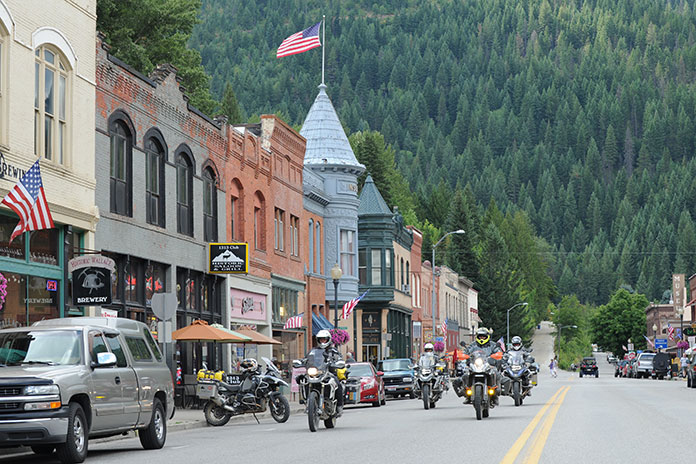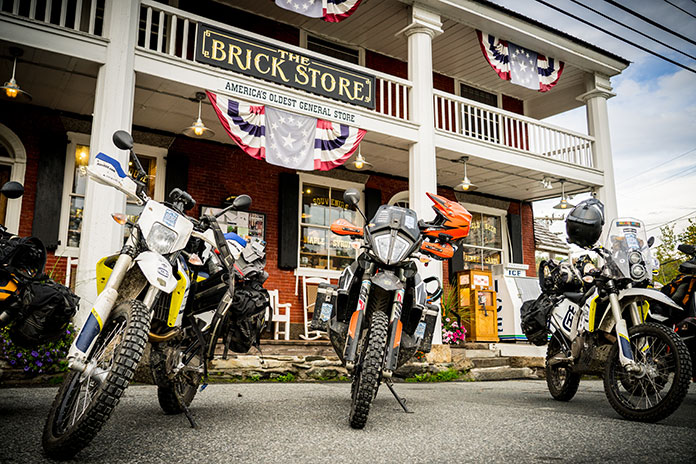Continuing in their mission of responsibly creating off-highway routes for adventure and dual-sport motorcycle travel, the nonprofit Backcountry Discovery Routes organization has released its 2023 Economic Impact Study white paper, which reports more than $60 million dollars in boosts to local economies in proximity to BDR routes. Of particular interest was the impact on smaller rural communities, where the increase in tourism dollars has helped offset declines in other industries such as mining or forestry. For more information, read the press release below.
SEATTLE – Backcountry Discovery Routes (BDR), the nonprofit organization dedicated to developing adventure riding opportunities across the U.S., just released its comprehensive Economic Impact Study white paper. The report underscores the role played by BDR riders in bolstering local economies, with BDR-related spending creating an annual economic impact of over $60 million across all BDR routes.
To access the complete economic impact study white paper and learn more about Backcountry Discovery Routes, visit the Economic Impact Study page on the BDR website.
Conducted in partnership with the University of Wyoming’s Center for Business and Economic Analysis (CBEA), the study examined visitor spending patterns among motorcyclists traveling on BDR routes. Key findings were derived from economic impact calculations, utilizing state-specific multipliers, industry-specific margins, estimates of out-of-state visitors, and average spending per industry and state.
One of the standout conclusions from the study is the substantial positive impact BDR has on small rural communities. As the organization continues to create new BDR routes, it brings a surge of economic activity to these areas in the form of tourism. The influx of commerce extends to various sectors, including hotels, campgrounds, restaurants, gas stations, grocery stores, parks, and more. Many of these rural communities have faced economic challenges due to declines in traditional industries such as mining and forestry, and BDR’s initiatives have proven to be an important source of new tourism revenue for these remote local economies.
Inna Thorn, executive director at Backcountry Discovery Routes, said that many states are looking for new outdoor recreation opportunities to help diversify their economies and bring new tourism dollars to local communities.
“This economic impact study underscores the substantial positive influence BDR has on the communities we travel through,” she said. “More than just an advocate for off-highway motorcycling, BDR is a catalyst for economic growth in rural communities along our routes. As we continue to expand our network of routes, we are committed to making a lasting and positive difference in these communities, while educating our riders about safe and respectful travel on public lands and in local communities.”
Related: Backcountry Discovery Routes | Ep. 58 Rider Magazine Insider Podcast
In addition, BDR efforts are also growing the sport by creating new adventure riders and driving motorcycle sales. The study found that BDR riders generated $9.6 million in motorcycle sales in 2022. BDR riders are not just buying motorcycles, they are also spending significant dollars on related products and services to prepare for a BDR ride.
BDR invites all interested parties, including policymakers, local officials, and motorcycling enthusiasts, to explore the full economic impact study white paper. By understanding the tangible benefits that BDR routes bring to rural areas, communities and stakeholders can work together to harness the potential for sustainable growth and development of adventure motorcycle tourism.
About Backcountry Discovery Routes
Backcountry Discovery Routes (BDR) is a 501c(3) nonprofit organization that creates off-highway routes for adventure and dual-sport motorcycle travel. The organization’s work includes promoting rider education and safety campaigns, driving economic relief to rural communities, and encouraging responsible motorcycle travel in the backcountry. Through the careful investment of funds and working with land managers and other public benefit organizations, BDR seeks to keep remote public roads open for motorcycling for generations to come.
BDR delivers turn-key trip planning resources to the community including GPS tracks, digital maps, travel information, route condition updates, YouTube videos, Q&As, and other information – all available 24/7 on the Backcountry Discovery Routes website. The organization relies on the generosity of donors and a team of volunteers and ambassadors who contribute thousands of hours each year to help carry out this mission.
Since 2010, BDR has created routes in Washington, Utah, Colorado, Arizona, Idaho, New Mexico, Nevada, the Mid-Atlantic region, Southern California, the North-East region, Wyoming, and Oregon and the soon-to-be-released Northern, California project. In 2022, BDR introduced a new concept of shorter, BDR-style routes that loop called BDR-X. Current BDR-X routes include Red Desert, Wyoming; PA Wilds, Pennsylvania; Steens Mountain & Alvord Desert, Oregon; and now the Black Hills, South Dakota.
See all of Rider‘s Backcountry Discovery Routes coverage here.












Not convinced the economic gains outweigh the environmental losses especially where ATVs, SxSs and UTVs share those same routes. Most particularly where the locals rent the aforementioned four wheeled vehicles to tourists with little care for the BDR system, but who instead just want to spend a day tearing up the trails just to see the dirt fly–and posing a threat to motorcyclists.